 |
THE 4 October 1980 M.V. PRINSENDAM
CRUISE SHIP FIRE and my participation in this incident response |
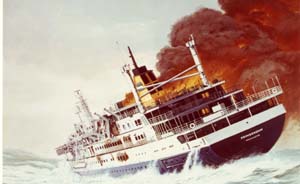 U.S
Coast Guard rescue
coordination centers began receiving Morse code SOS distress signals from
the M.S. Prinsendam reporting a fire onboard a few minutes prior to 1 a.m.
Saturday morning October 4, 1980. A few hours later at 05:08 a.m., with
fire visible on deck, 329 passengers were directed to take to lifeboats about 120
miles off shore in the frigid Gulf of Alaska.
U.S
Coast Guard rescue
coordination centers began receiving Morse code SOS distress signals from
the M.S. Prinsendam reporting a fire onboard a few minutes prior to 1 a.m.
Saturday morning October 4, 1980. A few hours later at 05:08 a.m., with
fire visible on deck, 329 passengers were directed to take to lifeboats about 120
miles off shore in the frigid Gulf of Alaska.
Despite the hardships and hazards of abandoning ship in the Gulf of Alaska about 120 miles off shore, all crew and passengers of the M.S. Prinsendam 329 passengers, 164 Indonesian crew members and 26 Dutch officers were successfully rescued. The combination of hardship, hazard, no loss of life, no significant injury has resulted in this incident being considered the greatest air-sea rescue operation in maritime history.
The first 12 to 24 hours of a distress incident offers the best chance of successful rescue and recovery of survivors. After 48 hours chances of a successful rescue and recovery decrease rapidly. The remote and isolated location of the burning Prinsendam and its lifeboats and life rafts was barely within the timely response capability of the personnel and equipment available. The risks included–but were not limited to–climatic, season, weather, distance from shore and logistics of getting rescue teams and resources to the burning Prinsendam's location. The survivabilty hazards to both survivors and rescuers included–but were not limited to–remoteness and isolation of the Prinsendam's location from help, water temperature, worsening weather and sea conditions combined with duration the survivors would be vulnerably exposed to the furry of sea and weather. The remnants of Typhoon Thelma heading directly towards the incident area would result in the operational envirnonment becoming more perilous during the on-going rescue operations.
With weather deteriorating and sea conditions worsening, time factors, distances factors, and large numbers of survivors needing rescuing there certainly was considerable potential for misplacing rescuers and survivors during the rescue operation. This indeed is what happened to the survivors and rescuers helping them on lifeboat No.6. I was there and this is what I remember.
A more thorough and inclusive telling of those
who participated in this rescue as rescuer, passenger, crew or in other support
roles can be found in published newspaper and magazine articles and at least one book. Here
are a few I know about.
H. Paul Jeffers. Burning Cold, The Cruise Ship Prinsendam and the Greatest Sea Rescue of All Time, St. Paul MN: Zenith Press, 2006. ISBN-13: 987-0-7603-2079-2
Joseph P. Blank. "Last Cruise of the Prinsendam." Readers Digest November 1983: 237-264.
Josh Eppinger. "The Prinsendam Fire, Histories Greatest Sea Rescue", Popular Mechanics April 1981: 102 -105 and 211-219.
"Captain Wabeke, a miraculous manipulator" and "Prinsendam, world's greatest rescue at sea" Alaskana Volume III, Number III 1980, 5and 6+
Lieutenant (junior grade) Thomas F. McCaffery, U. S. Naval Reserve "Williamsburgh to the Prinsendam's rescue", United States Naval Institute Proceedings Magazine", April 1981, 103-105.
To understand my participation in this rescue, an awareness of the distances and numbers of vessels and aircraft on scene to rescue and recover the crew and passengers from the lifeboats is needed. The complexity of the command and control, logistics, and operations was compounded by the remoteness and distances involved. This rescue was accomplished by many multi government agencies, several private sector merchant ships, and several volunteer organizations. It also deserves mention satellite communications, desktop computers, GPS navigation, and night vision technology was unavailable technology in 1980 and this lacking technology can be considered a problem pertinent to situation reporting and command and control.
 The
map to the right shows very approximately the 57-38 degrees North and 140-25
degrees West position of the burning MV Prinsendam on 4 October 1980. This
placed her approximately 330 miles Southeast of
Valdez Alaska, 129
miles South of Yakutat
Alaska, 195 miles West of Sitka.
Alaska and 429 miles East of
Kodiak Alaska.
The
map to the right shows very approximately the 57-38 degrees North and 140-25
degrees West position of the burning MV Prinsendam on 4 October 1980. This
placed her approximately 330 miles Southeast of
Valdez Alaska, 129
miles South of Yakutat
Alaska, 195 miles West of Sitka.
Alaska and 429 miles East of
Kodiak Alaska.
Yakutat Alaska is an isolated coastal fishing community having a permanent living population of less than 2000 individuals. There is no other community closer to the burning Prinsendam.
Sitka Alaska is a more robust and diversified community pertinent to technology, equipment, and communication resources and capability primarily because the Coast Guard has a small permanently manned airfield and station there.
The only other community of any substance of resources to be of any help to the crew and passengers of the burning Prinsendam closer than Kodiak, Anchorage, and Juneau is Cordova Alaska.
Thirteen rotary and fixed wing aircraft (US Coast Guard, US Air Force and Canadian Coast Guard), three US Coast Guard Cutters and three commercial vessels became the on-scene response and the command and control involved multi agency coordination and joint operations. This incident response is in my opinion the first best example of the effectiveness and purpose of the Incident Command System.
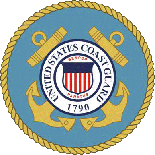 |
Four-(lacked air to air refueling capabilities)-H-3 helicopters--2 from CG Air Station Sitka (195 miles) and two from CG Air Station Kodiak (429 miles) Two HC-130H search and rescue fixed wing aircraft from CG Air Station Kodiak (429 miles) 378 ft cutter Boutwell docked in Juneau-Distance: 300 miles by sea. Arrive on scene at 2:30 p.m., 4 October 378 ft cutter Mellon diverted from near Vancouver enroute Alaska for fisheries patrol (550 nautical miles). Arrives on scene 5:05 a.m., 5 October. 180 foot Buoy Tender Woodrush docked in Sitka (195 miles). Arrives on-scene at 22:40 p.m., 4 October. |
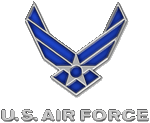 |
One air to air refueling capable HH-3 helicopter (over 370 miles) One HC-130P/N refueling tanker/communications/extended range search and rescue fixed wing aircraft (over 370 miles). Two pararescuemen were on the H-3 and three pararescuemen and an Air Force Flight Surgeon (not parachute/pararescue qualified) were on the HC-130. But with hurricane force winds imminent it was decided to land the HC-130 a transport the three pararescuemen and the flight surgeon to the US liquid/bulk tanker Williamsburgh to provide medical care to the passengers that were being recovered from the life boats. |
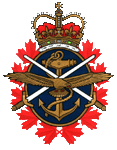 |
Two HH-46 Helicopters (lacked air to air refueling capabilities) from Canadian Forces Base Comox, Vancouver Island, British Columbia (600 miles) Two fixed wing Buffaloes and 1 Argus from Canadian Forces Base Comox, Vancouver Island, British Columbia (600 miles). A medical team and/or SAR Technicians were on board some or all the aircraft. At 1:45p.m. one of the Canadian HH-46 has an electrical fire and declares an emergency. This removes one helicopter from further participation in the rescue operations. |
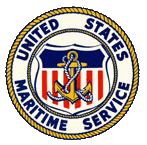 |
1000 foot US liquid/bulk tanker Williamsburgh out of Valdez bound for Texas (90 miles/5 hours away). First ship response to arrive on-scene at 07:43 a.m. 811 foot US liquid/bulk tanker SOHIO Intrepid out of San Francisco bound for Valdez Alaska. Arrives on scene at noon. 494 foot US container ship Greatland. 523 foot US container ship Portland bound for Anchorage Alaska. Arrives on scene 13:15 p.m. |
Weight and power limitations limit the helicopters from hoisting more than 6 to 15 survivors from the lifeboats before they had to be unloaded someplace so more survivors could be hoisted into the helicopter. The helicopters brought the survivors to one of the ships unless being low on fuel required the trip to Yakutat to refuel. Had this incident been further out to sea the US Coast Guard and Canadian Forces helicopters lacking air to air refueling capabilities could not have responded.
Now you have a general awareness of who was responding and of the dangers and hardships being encountered and dealt with there can be a better understanding of the story of missing lifeboat No. 6.
THE AIR FORCE AIR RESCUE CAPABILITY GETS DISPACHED
My participation in this rescue began at about 3 a.m. Saturday morning of October 4, 1980. I was the member of the weekend Air Force air rescue helicopter alert crew. As I was a qualified and experienced pararescue team leader, I was the only PJ on the crew this particular weekend. It was scheduled to be my last alert to as I had orders to report to a new permanent unit of assignment at Osan AB Korea. The phone call notifying me of the mission caught me sound asleep in my barracks room (I had a phone in my room) and at first I thought it was a practical joke being played on me.
It certainly took very little to make the leap that I was the subject of a prank. Besides being my last alert, our unit's touch football team, of which I was one of the players, had just won played the game that determined the 1980 Elmendorf AFB Intramural Flag Football Championship. Not only was it the first time our squadron commander allowed us to have a team, this season's flag football games were anything but not contact. Several teams ended up having a member break a bone and there was even a fractured jaw that happened in one game. Additionally a popular member of the unit was getting married that Saturday so there was a lot of festivities happening. Eventually it dawned on me that this mission was not a prank and I also realized it was to big of a mission for just one PJ and so I tried to find a PJ to go with me. I called a few and either got nobody to answer the phone or those that I did find were lacking the sobriety to go forth and do a mission. One of the persons I called was my immediate supervisor at my first duty assignment in Iceland four years in the past. He was a non-drinker, but had not gotten any sleep yet and declined to go with me. A decision that he regretted when he woke Sunday morning and reading the newspaper headline that morning that two PJ's missing at sea-worst feared, even though we had been found already.
The only PJ in the barracks was a rookie PJ that had been sent to our unit from McClellan AFB to get some arctic training. I didn't give him any options when I knocked on his door and told him he was going on a mission with me. This PJ was Jose Rios and unfortunately nine years later sometime during 1989 he was killed instantly in an automobile accident that happened in Galveston Texas.
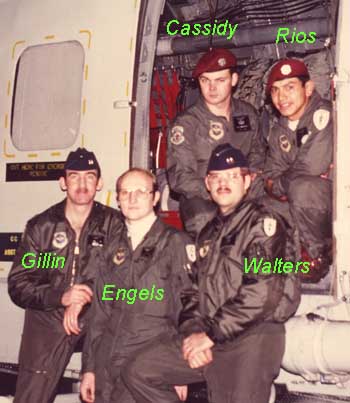 At about 4:35
a.m. the H-3 (AF Rescue 802) was off the runway at Elmendorf AFB and
heading towards the Prinsendam. Its crew was Captain John J. Walters-Aircraft
Commander; Captain William T. Gillen-Copilot; Staff Sergeant Michael J.
Engels-Flight Engineer; Staff Sergeant John F. Cassidy-Pararescue Team Leader;
and, Sergeant Jose M. Rios-Pararescue Specialist.
At about 4:35
a.m. the H-3 (AF Rescue 802) was off the runway at Elmendorf AFB and
heading towards the Prinsendam. Its crew was Captain John J. Walters-Aircraft
Commander; Captain William T. Gillen-Copilot; Staff Sergeant Michael J.
Engels-Flight Engineer; Staff Sergeant John F. Cassidy-Pararescue Team Leader;
and, Sergeant Jose M. Rios-Pararescue Specialist.
It wasn't long into the flight that the hazards were encountered. Getting to the Gulf of Alaska required going through the Portage Pass. Thirty minutes into the flight the crew found this pass was socked in with low clouds and poor visibility. After circling two or three time the beacon lights of the Whittier airport was spotted and we made a dash through the pass before the clouds closed in again. In route the H-3 (also known as Jolly Green Giant) was air to air refueled by the HC-130 (also known as King) tanker aircraft once or perhaps twice before we finally arrived at the burning Prinsendam.
THE AIR FORCE AIR RESCUE RESPONDERS ARRIVE ON-SCENE
The AF helicopter was on-scene at 08:50 a.m. and the only other helicopter we saw was a Coast Guard H-3 helicopter landing on the US liquid/bulk tanker Williamsburgh. The first task assigned us by the Coast Guard was to take a lot of blankets to the tanker Williamsburgh.
This was a fairly quick task and our next task was to pick a lifeboat and start hoisting survivors and bring them to the Williamsburgh. However nobody seemed to have an accurate count of the lifeboats and rafts in the water.
Lifeboat No. 6 was lowered into the water sometime before sunrise–7:35 a.m.–between 4:54 a.m. and 6:30 a.m. the morning of Saturday October 4th. For unknown reasons and causes during the darkness before sunrise lifeboat No. 6 had drifted further away from the burning Prinsendam than the other lifeboats and life rafts. Although all the lifeboats and life rafts were scattered and drifting aimlessly these other boats and rafts were somewhat grouped together and closer to the Prinsendam. From the very beginning of the rescue operation this being considerably further away was sufficient to allow No. 6 to be overlooked and forgotten.
We got to lifeboat No. 6 because during our crew discussion of which lifeboat should we start hoisting from it was brought up by the PJ team leader that in all mass causality situations the first step is to not presume you know where all the survivors/victims are, but survey to determine the boundaries of the incident site and locate position of all victims. So we decided to determine the boundaries of the incident area. As we flew around the grouped lifeboat and life rafts we spotted lifeboat No. 6 about a mile away from the group and decided that lifeboat needed our attention the most because it had apparently not been noticed by anybody else yet.
Resembling the
other the boats, No. 6 was similarly over crowded with more people than it
was designed to hold. Like the survivors in the other lifeboats, the
survivors in No. 6 were elderly and undressed in pajamas, night gowns, and
other leisure wear. Concerns of potential hypothermia, falling overboard
as they were being hoisted, and lack of understanding how to secure themselves
to the forest penetrator resulted in the decision to put the pararescuemen in
lifeboat No. 6.
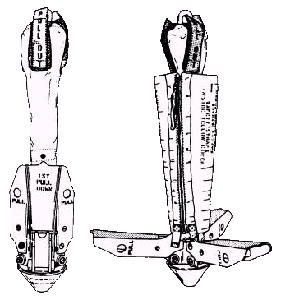
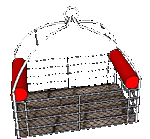
Unlike the U.S. Coast Guard and the Canadian forces rescue helicopter that lowered rescue baskets to hoist up survivors from the water, the Air Force helicopter was using a device known as the Forest or Jungle Penetrator. The forest penetrator required the person being hoisted to sit on the unfolded paddles (see illustration left) and then put a securing strap around themselves. The rescue basket just required the survivor to crawl into it and hang on while being hoisted.
The other difference is Coast Guard Helicopter Rescue swimmers didn't exist before prior to March 5, 1985. The Coast Guard certainly could have used some helicopter rescue swimmers as getting into a basket in rough seas is not as easy as many imagine it would be.
The PJs ARE PUT IN LIFEBOAT No. 6
At 9:05 a.m. the AF helicopter flew at 10 knots 10 feet above the water and as it
passed down wind/drift of lifeboat No. 6 the two PJs (Rios & Cassidy)
jumped from the helicopter into the water and swam to the lifeboat.
The lifeboat was designed for 60 people it was so overcrowded that neither PJ could actually get into the lifeboat. It was decided Sgt Rios would straddle the side of the lifeboat and secure the survivors to the forest penetrator while SSgt Cassidy monitored the hoist cable and be prepared to get anybody who fell into the water during the hoist operations. Of the two tasks monitoring the hoist cable and performing lifeguard duties for anybody falling out of the lifeboat was the more hazardous.
The swimmer in the waters job was to make sure the hoist cable didn't wrap around the arms, legs, and necks of anybody in the boat, to make sure the 18-pound steel Jungle Penetrator didn't hit anybody in the head or face, and to also prevent the cable from going under the lifeboat.
The sea state for a swimmer beside a lifeboat was quickly changing from manageable to hazardous. It took two hours to get sufficient survivors off the lifeboat to get sufficient safe working space to put survivors into the hoist seat and to properly secure them. After being slammed repeatedly against and under the lifeboat and swallowing saltwater SSgt Cassidy was almost to the point of having to get into the lifeboat or else. Helped aboard–hindered by exhaustion and blunt trauma–and sick from swallowing seawater SSgt Cassidy leaned over the side and vomited-and vomited.
Typically gaining work space to hoist from the lifeboat would mean the process of hoisting survivors has or would become easier.
A 10:20 a.m. Coast Guard situation report reports 12-15 foot waves and 25-30 knots wind. This meant 15-20 feet of cable slack was possible during the time it took to secure a person to the penetrator. By noon the wave were in excess of 20 feet. At 2:30 p.m. cloud ceiling was down to 220 feet above the sea surface, visibility had decreased to one mile and the weather was still deteriorating. This increasing wind and higher waves besides not making the safety swimmer duties any easier in the water was making hoist operations more hazardous.
All hoists went without any complications until SSgt Cassidy got into the lifeboat. The next to the last hoist done by the Air Force helicopter resulted in one of the hoisted survivors going into the water and fortunately she was properly secured to the forest penetrator which allowed the hoist operator got this elderly lady out of the water almost as fast as she went into the water. A number of hoisting of survivors later a wave exceeding 20 feet lifted the boat high and swinging on the crest so that the cable was completely under the lifeboat. When the lifeboat traveled to the bottom of the wave trough, the keel of the lifeboat snapped the steel hoist cable as if it was a thread. The snap was so clean and fast the person sitting on and secured in the forest penetrator felt no tug at all. The time was 1:50 p.m. and the AF helicopter was no longer able to do any more hoist operations.
The Air Force helicopter hoisted 42 people from lifeboat six before its hoist cable was sliced and the Coast Guard helicopters hoisted some 25 to 30 other survivors from lifeboat No. 6 until only twenty survivors and two PJs remained. The last helicopter to visit lifeboat No. 6 was a Coast Guard helicopter at about 3 p.m.
The weather at 3p.m. was deteriorating quicker than the approaching 6:38p.m. sunset. By 4p.m. waves were threatening to break over the sides of the lifeboat. Two PJs were getting very worried about the well being and safety of the survivors. At this time no ship or helicopters could be seen or heard. It was decided to search the lifeboat for all the equipment and supplies would could find. It was the best of good luck that Sgt Rios found the lifeboat cover stuffed on the bottom of the end of the boat he was searching. Initially it was used as a cover type shelter for the remaining 20-survivors who were herded to one end of the lifeboat.
At about 5 p.m. waves were beginning to occasionally break over the sides of lifeboat and the PJs became concerned the waves would eventually fill the lifeboat with water. We quickly decided to secure the boat cover storage tarp as it is when the life boat is not in use in the hope this would keep the boat empty of water. By this time a mixture of rain and sleet was also falling from the clouds.
Securing the tarp across the top of the lifeboat was easier thought of than accomplished in gale force if not hurricane force wind and 20 foot plus seas. We got in place and secure none to soon as the occasional wave was breaching the side of the lifeboat and this tarp was the only thing keeping the water from soaking the survivors.
With the tarp secured the full length of the lifeboat Jose Rios and I take turns doing our best under the tarp taking care of the survivors and tying ourselves to the lifeboat and sitting on the tarp hoping to spot a boat or an aircraft. Actually for the first few hours after sunset the visibility was close to zero and we were more worried about a ship running us over.
The PJs certainly-so tried to get attention of ships and aircraft after 3 p.m. by turning the emergency locator beacon I was carrying on. Coast Guard SITREPS report the brief hearing of an ELT on 243.0 MHZ at 15:20 p.m., but that it stopped. Standard procedure was being followed of transmit beacon for 5 minutes and listen for a response on the hour and half past the hour. The 15:20 p.m. transmission was made because we no longer heard or saw any ships or aircraft. The PRC-90 was working at least to 6:30 p.m. because a situation update message transcript indicates several boats reported hearing an ELT at 6:30 p.m.
I have no clue of how far lifeboat No. 6 was from the burning Prinsendam and the other lifeboats, but a 2:30 p.m. situation report made by the cutter Boutwell's reports the grouped lifeboats had drifted eight miles from the Prinsendam. I don't know how much further away lifeboat No. 6 was at this time other than we were very lonely after 3 p.m. and attempting to get noticed by turning on an emergency radio beacon and using signal flares.
At about 8 p.m. it was clear to me the radio and beacon was no longer working. Changing batteries did not result in obtaining a working radio or beacon. The PRC-90 is suppose to be waterproof, but apparently the seals failed allowing water into the circuits. This was verified to be the cause when the radio was subsequently inspected for repair. This left us with no electronic signaling and radio communications capability.
Several flares were used after sunset in hopes they might be seen if somebody was looking for us, but limited numbers of flares prevented frequent use unless we actually heard or saw a ship or aircraft. Meanwhile, we were not yet missed.
IT IS DETERMINED TWO PJS ARE MISSING
 Sunset
occurred at 6:38 p.m. and just a few minutes earlier at 6:16 p.m. all survivors and
crew from the Prinsendam were believed to be accounted for either on board the
CGC Boutwell, T/V Williamsburgh or in the town of Sitka. At this time the
M/V's Portland and SOHIO Intrepid were released from further rescue operations
and the T/V Williamsburgh proceeded enroute to Valdez, to off load survivors.
The CGC Boutwell is planning on departing the area departing area.
Sunset
occurred at 6:38 p.m. and just a few minutes earlier at 6:16 p.m. all survivors and
crew from the Prinsendam were believed to be accounted for either on board the
CGC Boutwell, T/V Williamsburgh or in the town of Sitka. At this time the
M/V's Portland and SOHIO Intrepid were released from further rescue operations
and the T/V Williamsburgh proceeded enroute to Valdez, to off load survivors.
The CGC Boutwell is planning on departing the area departing area.
At 9:43 p.m. Rescue Coordination Center Elmendorf asks Rescue Coordination Center Juneau where are the two PJs that were in the lifeboat. The cutter Boutwell responds with a message to Rescue Coordination Center Juneau that they could not account for the two PJs. It was at about this time a search mission was opened to find the two missing PJs.
At 10:10 p.m. command and control concluded one lifeboat is missing with two PJs and perhaps also a few survivors. Weather was now visibility a quarter mile and less, seas to 50 feet and winds 25-30 knots. At 22:40 CGC Woodrush arrives on scene and joins the search for the missing lifeboat. Worst of the weather has passed and belief is good chance lifeboat is still upright.
At about 00:30 a.m. Sunday morning, October 5, 1980 I spotted on the horizon what appeared to me at first to be a light house beacon. It was pretty windy but I knew of no light house on the coast of Alaska, so I was really beginning to wonder how far we had drifted. Either case, it was the first sighting of anything that might be looking for us. I lit off three emergency flares one right after the other. The light quickly no longer appeared to be sweeping with the appearance of a light house beacon, but rather it was held search light steady in our direction.
I only saw one ship, however Coast Guard situation reports indicate the cutter Woodrush observed a possible flare at 00:30 a.m. and the cutter Boutwell observed a possible flare a few minutes later at 00:33 a.m. Our position when the cutter Boutwell came alongside lifeboat No. 6 is reported as 57-47.4 degrees North and 141-18.4 degrees West.
The cutter Boutwell coming alongside the lifeboat is a understated misrepresentation completely opposite of overstated exaggeration. Weather and sea state was such that small boat operations were not possible. This resulted in using a rope and horse collar to manually hoist the twenty survivors and the two PJs from lifeboat No. 6. The maneuvering required to safely maneuver a 378 foot and 3 inch ship along side a lifeboat in 15-20 foot swells and 25 knot winds requires considerable seamanship. The Boutwell had to be careful that she was not blown on top of the lifeboat and that the lifeboat was not blown under the Boutwell. The Boutwell had to get so close that ropes lowered by crewmembers from the upper deck would get into the lifeboat where the PJs could put the remaining twenty survivors one after the other in a horse collars so they could be lifted out of the lifeboat to the lower deck.
I was the last person out of lifeboat No. 6. Not only do I vividly recall how much above and below the water line of the Boutwell each swell took us, I also recall seeing one of the two four-blade, 13" foot in diameter propellers come partially above the water when we drifted to the aft of the Boutwell before the Captain was able to correct the situation. It took from when the Boutwell got within shouting distance of lifeboat No. 6 at 1 a.m. to 2:09 a.m. to retrieve 20 survivors and two PJs from lifeboat No. 6.
The last twenty survivors in lifeboat No. 6 had been in it for slightly more than twenty hours and the PJs had been in the lifeboat for about seventeen hours. Not only did the PJs prevent lifeboat No. 6 from capsizing, the physicians who examined the last twenty survivors made it clear in their medical reports that these last twenty were less hypothermic and less emotionally distraught than most of the other survivors. Thus this rescue operation ended with not one casualty or major injury reported.
The official U.S. Coast Guard, Seventeenth District, M/V Prinsendam Afire Gulf of Alaska; SAR Case Study, 3 February 1981 Prinsendam Case had several favorable findings or perhaps recommendations pertaining to the Air Force and specifically the acts and deeds of the two pararecuemen who found themselves on lifeboat No. 6.
Rear Admiral Robert J. Knapp, U.S. Coast Guard District 17 Commander in his signed cover letter for this study makes the following comments:
"The training and expertise of the Air Force pararescuemen was responsible for the survival of passengers in the last lifeboat. It is notable that we were forced to rely on another agency to provide these personnel. I recommend we develop a similar, highly-trained, well equipped rescue elite."
AND
"Because of inflight refueling capabilities, the U.S Air Force H-3 helicopter was able to remain airborne for eleven continuous hours. Had this incident been further at sea our Coast Guard helicopters could not have responded. I recommend the Coast Guard actively pursue the HIFR Certification program and investigating the feasibility of equipping our present H-3 aircraft with an air to air refueling capability."
Of other historical note, the U.S. Coast Guard took action to establish its rescue elite after February 12, 1983. The first qualified U.S. Coast Guard Helicopter Rescue Swimmers were assigned to helicopter units effective March 5, 1985.
The U.S. Coast Guard for purpose of celebrating its 217th birthday compiled a list of the top ten missions in the Coast Guard's history. The M/V Prinsendam maritime rescue lists second among the top ten rescues of all time the Coast Guard accomplished between 4 August 1790 and 4 August 2007.